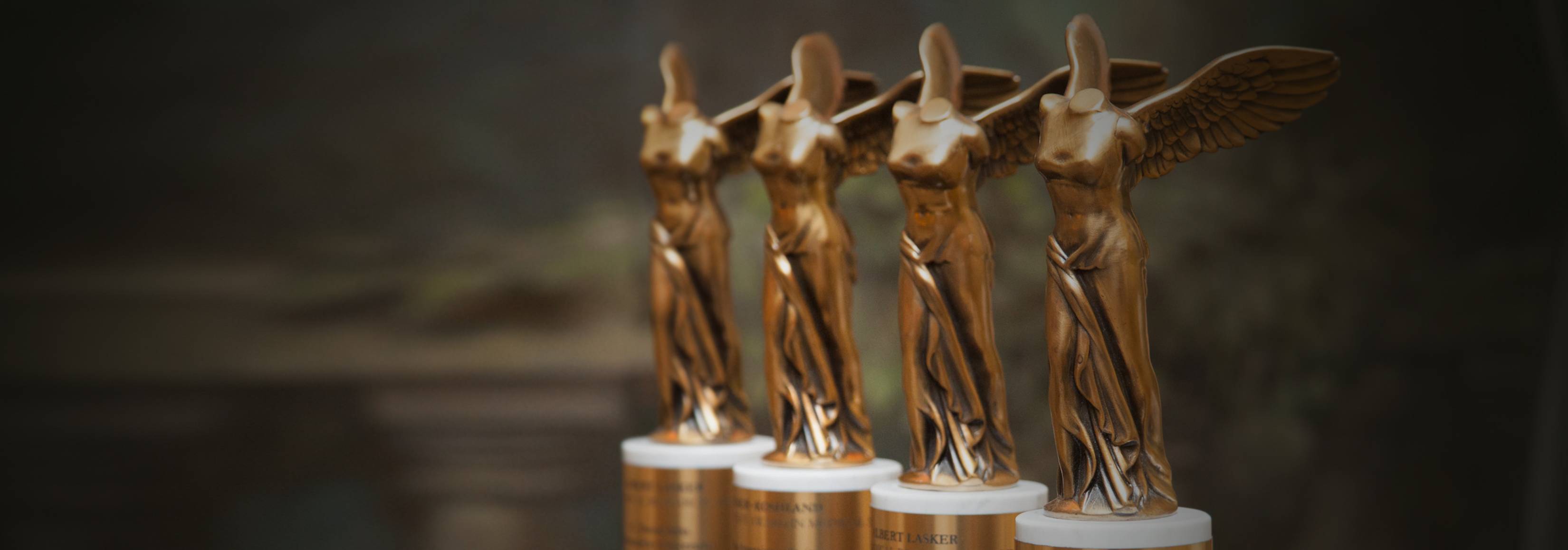The challenge for cell biologists in the mid-twentieth century was not unlike the challenge for astronomers. Belgian biologist Albert Claude put it, “the cell was as distant from us as the stars and galaxies.” At that time, the inner workings of the cell, millions of times smaller than the head of a pin, were invisible to even the best light microscopes. The electron microscope, first invented by German engineers in 1931, proposed a solution to the problem of cell biology with its much higher magnification power. But preparing live cells for the technology proved an obstinate hurdle. In the 1940s and ’50s, George E. Palade, a graduate student in Dr. Claude’s laboratory at The Rockefeller Institute for Medical Research, helped modernize the field of cell biology by removing this hurdle. For this work and his subsequent discoveries of the structure and function of cellular components, he was awarded the 1966 Albert Lasker Basic Medical Research Award.
To microscopists in the early 20th century, the sheer number of components in a living cell made it appear a jumbled, indecipherable mass. In 1930, Dr. Claude devised a technique, later perfected by Dr. Palade and by separate investigations of biochemist Christian de Duve (who later joined the Rockefeller faculty), to separate the functional parts of a cell and thus allow for clearer examination with powerful electron microscopes. Called cell fractionation, Dr. Claude’s method involves grinding cells in order to break the cell membrane and then sorting the released contents by mass and weight through precisely calibrated cycles of centrifugation.
Dr. Palade further refined the method of cell fractionation and combined it with techniques of sample preparation he had developed to look closer at certain cytoplasmic elements of the cell, particularly the endoplasmic reticulum, first observed by Dr. Claude and colleague Keith Porter. Drs. Palade and Porter described the endoplasmic reticulum as a series of meticulously folded membranes that fill most of the cytosol. Dr. Palade also discovered the ribosomes, small granular components attached to the endoplasmic reticulum that are responsible for protein synthesis in the cell. He and his colleagues also characterized in detail the process of protein secretion in secretory cells, and revealed numerous structure-function relationships of cellular components.
As Dr. Palade’s discoveries show, cell fractionation provided an unprecedented opportunity to peer inside the once-cloistered world of the cell, and he and his colleagues were prolific in their examination and biochemical analysis of each distinct constituent of various cell types. Their work over the next few decades resulted in the first functional map of the cell, and what they revealed was an entire microcosm: In addition to the ribosomes, they discovered the mitochondria, power plant of the cell; lysosomes, the cell’s clean-up crew; vacuoles, which police harmful elements; and many other, even smaller subcellular components.
By the early 1950s, cell biology was a recognized field. In 1955, The Journal of Cell Biology was established at The Rockefeller Institute, and in 1960, the American Society for Cell Biology was founded. Dr. Palade was directly involved in these and other ventures of the burgeoning new field he was instrumental in creating. Dr. Claude described the researchers’ discoveries collectively: “We have entered the cell, the mansion of our birth, and started the inventory of our acquired wealth.”
CAREER
Born in Iasi, Romania, in 1912, Dr. Palade developed his interest in basic research during medical studies at the University of Bucharest. Following military service during World War II, he moved to the United States to continue his studies, first at New York University and moving in 1946 to The Rockefeller Institute laboratory of Dr. Claude. He was appointed professor and head of laboratory at Rockefeller in 1958. Resigning from Rockefeller in 1973, he went on to Yale University Medical School, where his laboratory combined the new field of cell biology with clinical medicine. In 1990, he became professor of cellular and molecular medicine and dean for scientific affairs at the University of California, San Diego, a position he held until his death in 2008. In addition to the Lasker Award, Dr. Palade was the recipient of the 1986 National Medal of Science and the 1974 Nobel Prize in Physiology or Medicine.
